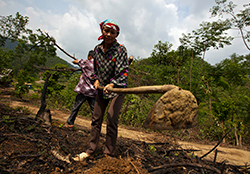Land
 Land is the basis for agriculture and other rural land uses, encompassing soils, climate, vegetation, topography and other natural resources. The UN defines land as “a delineable area of the earth’s terrestrial surface, encompassing all attributes of the biosphere immediately above or below this surface including those of the near-surface climate, the soil and terrain forms, the surface hydrology (including shallow lakes, rivers, marshes and swamps), the near-surface sedimentary layers and associated groundwater reserve, the plant and animal populations, the human settlement pattern and physical results of past and present human activities”.
Land is the basis for agriculture and other rural land uses, encompassing soils, climate, vegetation, topography and other natural resources. The UN defines land as “a delineable area of the earth’s terrestrial surface, encompassing all attributes of the biosphere immediately above or below this surface including those of the near-surface climate, the soil and terrain forms, the surface hydrology (including shallow lakes, rivers, marshes and swamps), the near-surface sedimentary layers and associated groundwater reserve, the plant and animal populations, the human settlement pattern and physical results of past and present human activities”.
 The term “land resources” encompasses the physical, biotic, environmental, infrastructural and socio-economic components of a natural land unit, including surface and near-surface freshwater resources important for management. The interaction between the components of land resources is vital for determining the productivity and sustainability of agro-ecosystems. The resilience of the system to endure and adapt to natural (e.g. climate change and variability) and human-induced (e.g. land use and management) changes and fluctuations is determined by the status and endurance of the land resource components and their interactions.
The term “land resources” encompasses the physical, biotic, environmental, infrastructural and socio-economic components of a natural land unit, including surface and near-surface freshwater resources important for management. The interaction between the components of land resources is vital for determining the productivity and sustainability of agro-ecosystems. The resilience of the system to endure and adapt to natural (e.g. climate change and variability) and human-induced (e.g. land use and management) changes and fluctuations is determined by the status and endurance of the land resource components and their interactions.

FAO is responding to the need to increase food production from a degraded natural resource base by supporting the restoration of land productivity and ecosystem services. The availability of timely information on the status of, and trends in, land resources and human–ecosystem interactions are crucial for decision-making by farmers, local and provincial authorities, and national governments.
FAO supports countries in restoring productivity, combating land degradation and maintaining ecosystem services from land resources by (among other things):
- assessing the status of, and trends in, land resources;
- developing land resource planning tools and governance and decision-support systems;
- managing and implementing Sustainable Land Management (SLM) at the farm, landscape and national scales;
- monitoring and assessing impacts; and
- managing knowledge to better inform decision-makers and stakeholders and to influence policy-making processes.

